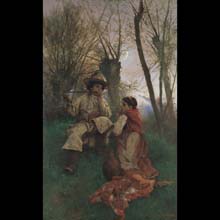
material: oil on canvas
dimensions: 251 × 160 cm
description: Witold Pruszkowski’s interests focussed on the world of fantasy. Drawing on the fantastic and native folklore held a special place in his creative work. His paintings revived the world of water nymphs and goddesses, demons, werewolves as well as the legendary robber Madej. They also depicted the rituals of the Midsummer Night’s Eve, All Souls’ Day and St. John’s Eve. The motif of a pastoral scene (idyll) derived from the work of ancient writer Theocritus. As in the case of Spring Humming by Aleksander Kotsis, the ancient motif has been combined with folklore here. The landscape, plunged into half-darkness and illuminated by the light of the moon, provides the atmospheric setting for a couple lost in melancholy reverie. The fact that people are dressed in Krakow costumes and the landscape with a motif of branched willows give the composition a familiar, native quality. The realistic style is combined with the depiction typical of Symbolism. The vertical composition, devoid of depth, is emphasized by the format of an elongated vertical rectangle, adopted from the Munich circle. Aleksandra Krypczyk
exposition: The Gallery of 19th Century Polish Art in Sukiennice,
The Cloth Hall, 1, Main Market Square
key: Realism, polish impressionism, beginnings of symbolism >>>
dimensions: 251 × 160 cm
description: Witold Pruszkowski’s interests focussed on the world of fantasy. Drawing on the fantastic and native folklore held a special place in his creative work. His paintings revived the world of water nymphs and goddesses, demons, werewolves as well as the legendary robber Madej. They also depicted the rituals of the Midsummer Night’s Eve, All Souls’ Day and St. John’s Eve. The motif of a pastoral scene (idyll) derived from the work of ancient writer Theocritus. As in the case of Spring Humming by Aleksander Kotsis, the ancient motif has been combined with folklore here. The landscape, plunged into half-darkness and illuminated by the light of the moon, provides the atmospheric setting for a couple lost in melancholy reverie. The fact that people are dressed in Krakow costumes and the landscape with a motif of branched willows give the composition a familiar, native quality. The realistic style is combined with the depiction typical of Symbolism. The vertical composition, devoid of depth, is emphasized by the format of an elongated vertical rectangle, adopted from the Munich circle. Aleksandra Krypczyk
exposition: The Gallery of 19th Century Polish Art in Sukiennice,
The Cloth Hall, 1, Main Market Square
key: Realism, polish impressionism, beginnings of symbolism >>>












